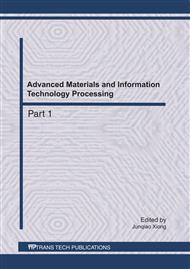[1]
P. Shatadal, D.S. Jayas, N.R. Bulley: Digital image analysis for software separation and classification of touching grains: I. Disconnect algorithm. Transactions of the ASAE. Vol. 38 (2) (1995), pp.635-643.
DOI: 10.13031/2013.27876
Google Scholar
[2]
J. C. Russ: The image processing handbook, third ed., CRC Press LLC in cooperation with IEEE Press, Boca Raton, FL, (1998), p.771.
Google Scholar
[3]
N. S. Shashidhar, D. S. Jayas, T. G. Crowe, et al: Processing of digital images of touched kernels by ellipse fitting, Canadian Agricultural Engineering. Vol. 39 (2) (1997), pp.139-142.
Google Scholar
[4]
N. S. Visen, N. S. Shashidhar, J. Paliwal, et al: Identification and segmentation of occluding groups of grain kernels in a grain sample image. Journal of Agriculture Engineering Research. Vol. 79 (2) (2001), pp.159-166.
Google Scholar
[5]
M. A. Shahin, S. J. Symons: Seed sizing from images of non-singulated grain samples, Canadian Biosystems Engineering. Vol. 47 (3) (2005), pp.49-55.
Google Scholar
[6]
Y. Ling, Y. M. Wang, M. Sun, et al: Application of watershed algorithm to paddy image segmentation, Transactions of the Chinese Society for Agricultural Machinery. Vol. 36 (3) (2005), pp.71-74.
Google Scholar
[7]
W. Wang, J. Paliwal: Separation and identification of touching kernels and dockage components in digital images, Canadian Biosystems Engineering. Vol. 48 (2006), p.7. 1-7. 7.
Google Scholar
[8]
X. M. Chen, G. Q. Guo, M. Q. Liu, On infrared image segmentation algorithm based on watershed, Journal of Optoelectronics. Laser. Vol. 112 (10) (2001), pp.1072-1075.
Google Scholar
[9]
L. Vincent, P. Soille: Watersheds in digital spaces: an efficient algorithm based on immersion simulations, IEEE Transactions on Pattern Analysis and Machine Intelligence. Vol. 13 (6) (1991), pp.583-589.
DOI: 10.1109/34.87344
Google Scholar
[10]
S. Beucher, Watershed, hierarchical segmentation and waterfall algorithm, In: J. Serra, P. Soille (Eds. ), Mathematical. Morphology and Its Applications to Image Processing, Kluwer. Academic Publishers, Netherlands, 1994, pp.171-203.
DOI: 10.1007/978-94-011-1040-2_10
Google Scholar
[11]
V. Grau, A. U. J. Mewes, M. Alcaniz, Improved watershed transform for medical image segmentation using prior information, IEEE transactions on medical imaging. Vol. 23 (4) (2004), pp.447-458.
DOI: 10.1109/tmi.2004.824224
Google Scholar
[12]
F. J. Kuang, W. H. Xu, Y. H. Wang: Research on broken rice rate detection using region labeling, Computer Engineering and Applications. Vol. 46 (12) (2010), pp.204-206.
Google Scholar
[13]
D. Y. Huang, C. H. Wang: Optimal multi-level thresholding using a two-stage Otsu optimization approach, Pattern Recognition Letters. Vol. 30 (2009), pp.275-284.
DOI: 10.1016/j.patrec.2008.10.003
Google Scholar


